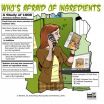(Press-News.org) Daily headlines on internet pages and blogs claim: "New ingredient X is harmful to your health." Such warnings can scare people into avoiding these ingredients without actually knowing the facts, leading some people to have food fears about ingredients such as sugar, fat, sodium, high-fructose corn syrup (HFCS), mono sodium glutamate (MSG), and others. While some of these food fears are merited, others can be misleading.
A new Cornell University study published in Food Quality and Preference, investigated who might be most prone to food fears, why, and what can they do to correct misperceptions. The phone survey of 1008 US mothers investigated what they thought about the food ingredient HFCS. When comparing those who avoided HFCS with those who did not, the study uncovered three key findings about avoiders: 1) They were more likely to receive their information from the internet rather than TV, 2) they had a desire to have their food related choices known by their friends or reference groups, and 3) they were not willing to pay more for foods that instead contained regular table sugar when compared to peers who did not avoid HFCS.
Researchers found that giving consumers more information about the ingredient such as its history can be effective in reducing ingredient fears. To arrive at this conclusion they asked participants to rate the healthfulness of Stevia, a natural sweetener. Half of the participants were given historical and contextual information to read about the product and the remaining participants were not given anything to read. Those who received information about an ingredient's history rated the product as healthier than those who did not. Lead author Brian Wansink recommends, "To overcome food ingredient fears, learn the science, history, and the process of how the ingredient is made, and you'll be a smarter, savvier consumer."
INFORMATION:
For more information, a copy of the paper, a free-to-use illustration and a video please visit: http://foodpsychology.cornell.edu/op/food-fear
Food ingredient fears
Increasing familiarity is the best way to avoid ingredient-based food fear
2014-06-25
ELSE PRESS RELEASES FROM THIS DATE:
Young researcher discovers source of disco clams' light show
2014-06-25
Four years after falling in love with the disco clam – a cute little mollusk known for its underwater light show – Lindsey Dougherty has discovered the secret of its mirrored lips.
A dive instructor and University of California, Berkeley, graduate student, Dougherty first encountered the two-inch clam in 2010 while diving with her mother and sister in Wakatobi, Indonesia. She and her sister even did a bit of underwater disco dancing to the clam's flashing beat.
"I've dived with humpback whales and great white sharks," said Dougherty, who first learned to dive at age ...
Hidden origins of pulmonary hypertension revealed by network modeling
2014-06-25
Boston, MA – In a groundbreaking study, researchers from Brigham and Women's Hospital (BWH) have identified a related family of molecules believed to be a major root cause of pulmonary hypertension, a deadly vascular disease with undefined origins. This is one of the first studies to leverage advanced computational network modeling to decipher the molecular secrets of this complex human disease.
The study is published online June 24, 2014 in The Journal of Clinical Investigation.
Despite the rising number of people diagnosed with the disease worldwide, pulmonary hypertension ...
Meeting Aichi biodiversity targets for protected areas
2014-06-25
Habitat loss is a primary driver of biodiversity loss – so it isn't surprising that optimising the amount of protected land is high on policy-makers' priorities. However, according to research to be published in the Open Access journal PLOS Biology on June 24 by Oscar Venter and colleagues, many protected areas are established in locations of low economic value, failing to protect the imperilled biodiversity found on more valuable land. More of the earth's land surface is set to be protected in the next decade, but the trend of using poor quality land seems set to continue. ...
Engineered bacteria keep mice lean
2014-06-25
Obesity levels are rising throughout the world. As obesity rates increase, so do the incidences of diabetes, heart disease, and other serious health conditions. The bacteria within an individual's gut can influence their susceptibility to these disorders. Therefore, altering the microbe population in the gut could prevent or reverse disease. A June 24th study in the Journal of Clinical Investigation demonstrates that modified bacteria can prevent weight gain in mice. Sean Davies and colleagues at Vanderbilt University made bacteria that produce a compound called NAPE, ...
Estrogen receptor β limits breast cancer growth and indicates outcome
2014-06-25
Millions of women will develop breast cancer at some point in their lives. While many women will completely recover from this cancer, others will not respond to treatment, and predicting which women will not respond to treatment is currently difficult. Breast cancer cells divide rapidly, and treatments that can restrict their growth are of great interest. In a June 24th study in the Journal of Clinical Investigation, Rong Li and colleagues at the University of Texas determined that activation of the estrogen receptor β (ERβ) limits tumor cell growth. Cancer cells ...
Novel biomarker predicts febrile seizure-related epilepsy, UCI study finds
2014-06-25
Irvine, Calif. — A newly discovered biomarker – visible in brain scans for hours after febrile seizures – predicts which individuals will subsequently develop epilepsy, according to UC Irvine researchers. This diagnostic ability could lead to improved use of preventive therapies for the disorder.
A team led by Dr. Tallie Z. Baram found that rats exhibiting this novel signal in magnetic resonance imaging scans of their brains manifested symptoms of epilepsy months after experiencing very long febrile seizures. Those that did not possess this biomarker remained free of ...
Team explains how mutated X-linked mental retardation protein impairs neuron function
2014-06-25
Cold Spring Harbor, NY – There are new clues about malfunctions in brain cells that contribute to intellectual disability and possibly other developmental brain disorders.
Professor Linda Van Aelst of Cold Spring Harbor Laboratory (CSHL) has been scrutinizing how the normal version of a protein called OPHN1 helps enable excitatory nerve transmission in the brain, particularly at nerve-cell docking ports containing AMPA receptors (AMPARs). Her team's new work, published June 24 in the Journal of Neuroscience, provides new mechanistic insight into how OPHN1 defects can ...
Animal study unveils predictive marker for epilepsy development following febrile seizure
2014-06-25
Washington, DC — Within hours of a fever-induced seizure, magnetic resonance imaging (MRI) may be able to detect brain changes that occur in those most likely to develop epilepsy later in life, according to an animal study published in the June 25 issue of The Journal of Neuroscience. The findings may one day help improve methods to detect children at a heightened risk for developing epilepsy and guide efforts to prevent epilepsy development in those at greatest risk.
Febrile seizures — convulsions brought on by fever — typically last only a few minutes and are relatively ...
How aging can intensify damage of spinal cord injury
2014-06-25
COLUMBUS, Ohio – In the complex environment of a spinal cord injury, researchers have found that immune cells in the central nervous system of elderly mice fail to activate an important signaling pathway, dramatically lowering chances for repair after injury.
These studies were the first to show that spinal cord injuries are more severe in elderly mice than in young adults, corroborating previous anecdotal findings from clinical settings. They also revealed a previously unknown player in the repair of spinal cord injuries in young adults.
A key messenger in that pathway ...
Study finds world's protected areas not protecting biodiversity, but there is room for hope
2014-06-25
Scientists from James Cook University, the Wildlife Conservation Society, the University of Queensland, Stanford University, BirdLife International, the International Union for Nature Conservation, and other organizations have warned that the world's protected areas are not safeguarding most of the world's imperilled biodiversity, and clear changes need to be made on how nations undertake future land protection if wildlife is going to be saved. These findings come at a time when countries are working toward what could become the biggest expansion of protected areas in history.
The ...
LAST 30 PRESS RELEASES:
Mount Sinai Health system receives $8.5 million NIH grant renewal to advance research on long-term outcomes in children with congenital heart disease
Researchers develop treatment for advanced prostate cancer that could eliminate severe side effects
Keck Medicine of USC names Christian Pass chief financial officer
Inflatable fabric robotic arm picks apples
MD Anderson and SOPHiA GENETICS announce strategic collaboration to accelerate AI-driven precision oncology
Oil residues can travel over 5,000 miles on ocean debris, study finds
Korea University researchers discover that cholesterol-lowering drug can overcome chemotherapy resistance in triple-negative breast cancer
Ushikuvirus: A newly discovered giant virus may offer clues to the origin of life
Boosting the cell’s own cleanup
Movement matters: Light activity led to better survival in diabetes, heart, kidney disease
Method developed to identify best treatment combinations for glioblastoma based on unique cellular targets
Self-guided behavioral app helps children with epilepsy sleep earlier
Higher consumption of food preservatives is associated with an increased risk of type 2 diabetes
NTU Singapore-led team captures first-ever ‘twitch’ of the eye’s night-vision cells as they detect light, paving the way for earlier detection of blindness-causing diseases
Global aviation emissions could be halved through maximising efficiency gains, new study shows
Fewer layovers, better-connected airports, more firm growth
Exposure to natural light improves metabolic health
As we age, immune cells protect the spinal cord
New expert guidance urges caution before surgery for patients with treatment-resistant constipation
Solar hydrogen can now be produced efficiently without the scarce metal platinum
Sleeping in on weekends may help boost teens’ mental health
Study: Teens use cellphones for an hour a day at school
After more than two years of war, Palestinian children are hungry, denied education and “like the living dead”
The untold story of life with Prader-Willi syndrome - according to the siblings who live it
How the parasite that ‘gave up sex’ found more hosts – and why its victory won’t last
When is it time to jump? The boiling frog problem of AI use in physics education
Twitter data reveals partisan divide in understanding why pollen season's getting worse
AI is quick but risky for updating old software
Revolutionizing biosecurity: new multi-omics framework to transform invasive species management
From ancient herb to modern medicine: new review unveils the multi-targeted healing potential of Borago officinalis
[Press-News.org] Food ingredient fearsIncreasing familiarity is the best way to avoid ingredient-based food fear


